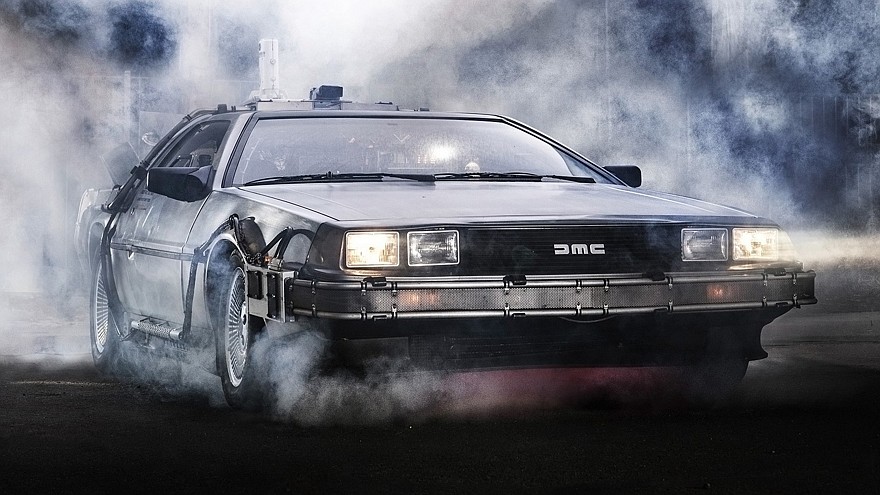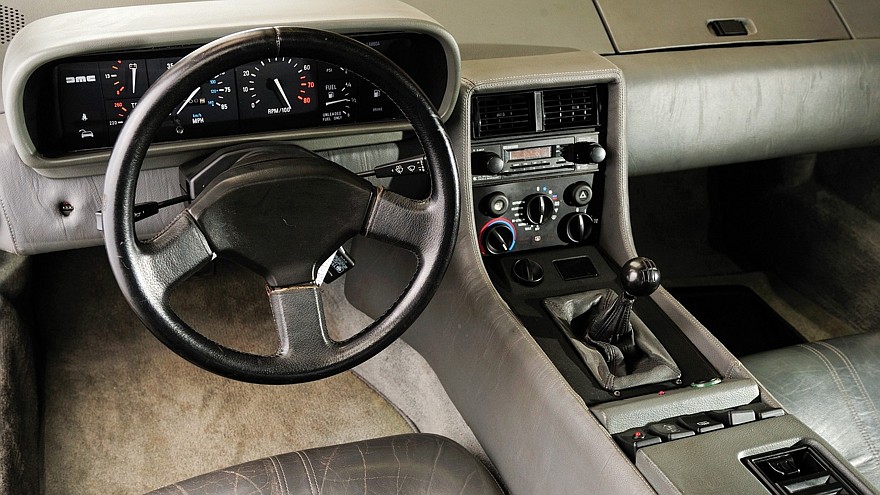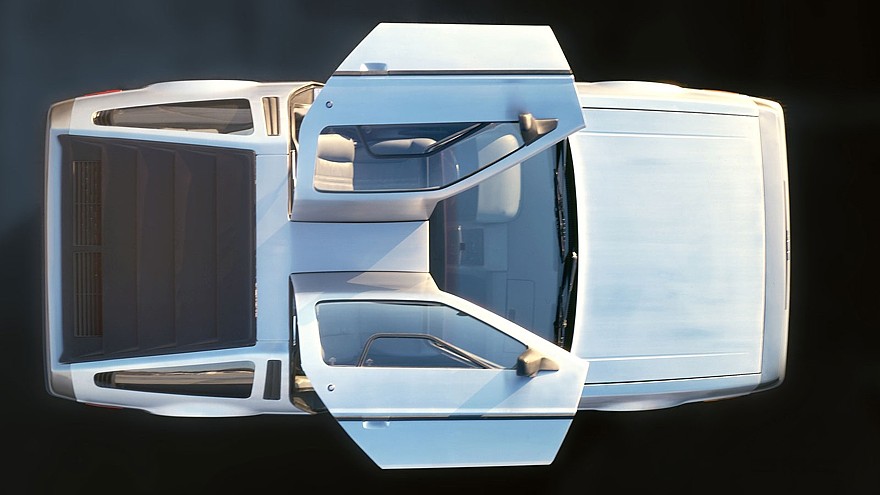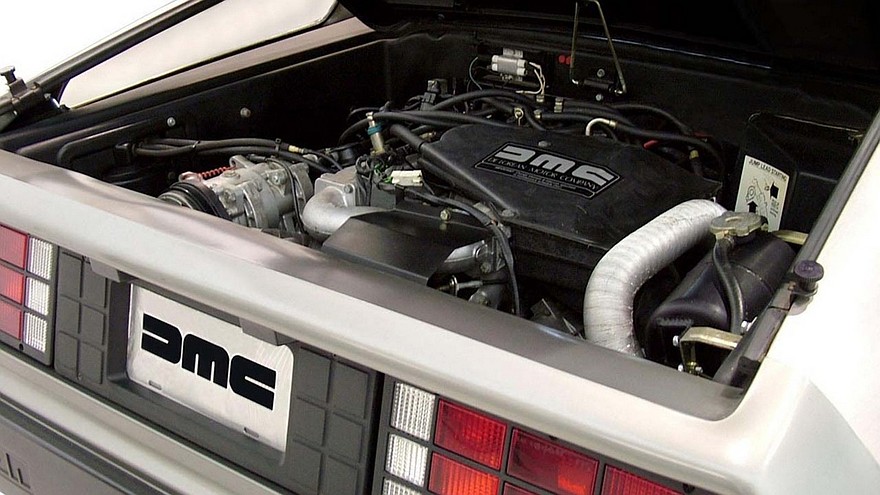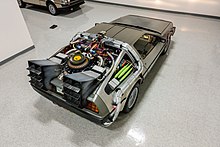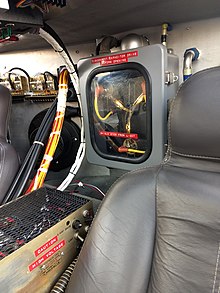Как сложилась судьба легендарных из «ДеЛорианов» из «Назад в будущее»?
DeLorean DMC-12 — идеальная основа для машины времени Дока Брауна. Блестящий корпус из нержавеющей стали, аэродинамическая форма, двери-«чайки»… для того времени это была одна из самых футуристичных машин.
К сожалению, DeLorean был обречен с самого начала. Единственным местом, где Джон ДеЛореан (основатель фирмы) смог найти завод, был Данмерри, Северная Ирландия, где у сотрудников был острый недостаток опыта работы. К проблемам добавился мировой топливный кризис, и ДеЛореану пришлось использовать двигатель с достаточно спорными характеристиками.
В довершение всего Джон ДеЛориан был обвинен в торговле наркотиками, и, хотя его признали невиновным через несколько лет, компания DeLorean Motor Company всё равно обанкротилась.
К счастью для DMC-12, популярность фильма «Назад в будущее» почти в одиночку спасла культовый автомобиль от забвения. Благодаря буму популярности он стал предметом коллекционирования — многие поклонники франшизы считают его идеальным подарком и сейчас.
Из 9 000 выпущенных автомобилей сохранилось около 6 500, и большинство из них — благодаря фильму. Также были выпущены некоторые специальные версии, такие как позолоченные DeLorean и модели с левым рулем.
Однако самыми известными экземплярами являются семь автомобилей, использовавшихся в трилогии «Назад в будущее». Большая их часть сохранились до наших дней:
-
Автомобиль «А», прозванный «Героем», был основным DeLorean, использовавшимся в фильме «Назад в будущее», часть I. Он тщательно охраняется компанией Universal благодаря своему полированному внешнему виду и сложным внешним декорациям.
-
Автомобиль «В», который использовался в сценах вождения, зовётся «Обломком» и был повреждён поездом в третьей части серии. Его останки отремонтировали, и сейчас он принадлежит частной выставке Билла и Патрика Ши в Массачусетсе.
-
Автомобиль «С» был разобран во время съемок фильма для создания интерьера. После его части были использованы для создания реплики, проданной частной японской компании.
-
Остальные четыре автомобиля DeLorean, использовавшиеся в трилогии, послужили донорами и дублёрами.
Спорткар DeLorean DMC 12 из культовой трилогии Роберта Земекиса «Назад в будущее» продают с молотка в Британии. Владелец утверждает, что купил автомобиль три года назад, и хочет получить за него £35 тыс. Покупателю автомобиля он готов подарить реплику ховерборда, на котором летал Марти Макфлай, его кепку, самозашнуровывающиеся ботинки и спортивный альманах. Владелец утверждает, что автомобиль находится в идеальном состоянии и прошел чуть больше 22,5 тыс. км.
Объявление о продаже «машины времени», на которой Марти Макфлай передвигался в компании своего приятеля, ученого Эммета Брауна, появилось на сайте британского онлайн-аукциона Shpock, пишет Daily Mail. Продавцом оказался некий Darren S., проживающий в деревушке Гарфорт графства Йоркшир. Он утверждает, что приобрел автомобиль три года назад у такого же фаната картины «Назад в будущее» из Нью-Йорка. При этом у DeLorean было всего два владельца.
«Я всегда любил «Назад в будущее», поэтому просто обязан был купить эту машину», — рассказал владелец спорткара.
Автомобиль был собран в 1981 году, имеет пробег всего 22,5 тыс. км и, по словам продавца, находится в идеальном состоянии. Несмотря на то что спорткар продается в Англии, где движение левосторонее, он оборудован левым рулем для правосторонних дорог. Салон и сиденья машины отделаны кожей.
Хотя машина в действительности, конечно, не летает и не перемещается во времени, владелец хочет получить за нее £35 тыс., что по текущему курсу составляет около 2,5 млн руб.
Кроме того, в придачу к автомобилю продавец подарит копию летающего ховерборда, на котором передвигался Макфлай, его самозашнуровывающиеся ботинки, спортивный альманах и кепку, которую носил главный герой кинотрилогии.
Спорткар DeLorean DMC 12 выпускался в Северной Ирландии для американской автомобильной компании DeLorean Motor Company с 1981 по 1983 год. Автомобиль был оснащен 6-цилиндровым 150-сильным двигателем PRV объемом 2849 куб. см. Примечательно, что мотор в DMC 12 располагался в задней части корпуса. Спорткары в зависимости от комплектации оснащались 5-ступенчатой механической или 3-ступенчатой автоматической коробкой передач.
Кузов автомобиля был выполнен из композитных материалов, а сверху обшит наполированными до блеска металлическими листами, из-за этого споркар получился стойким к коррозии. DeLorean оснащался дверьми типа «крылья чайки», которые открывались вверх.
Первый опытный образец автомобиля появился в октябре 1976 года. Спустя два года в окрестностях ирландского Белфаста началось строительство завода для производства DMC 12. Предполагалось, что спорткар пойдет в серию уже в 1979 году, однако впоследствии старт массового производства перенесли на 1981 год. Из-за высокого уровня безработицы в те годы в Северной Ирландии завод заполонило большое количество неопытных рабочих. В связи с этим качество первых автомобилей было очень низким.
Спорткары собирались в спешке и вызывали множество нареканий у покупателей. Несмотря на то что производитель устанавливал на автомобили гарантию в пять лет или 80 тыс. км пробега, большинство DMC 12 попадали в ремонт гораздо раньше этого срока.
Низкое качество продукции в конце концов привело к падению авторитета компании и ее банкротству. Более того, в октябре 1982 года владелец производства Джон Делореан был арестован ФБР по делу о распространении наркотиков. Впоследствии он был признан невиновным, однако этот процесс сказался на его статусе — банки перестали выдавать Делореану кредиты, а правительство прекратило финансирование его проектов. Вскоре после этого завод в Ирландии был закрыт. Впрочем, пылившиеся на складах непроданные автомобили в последующие несколько разошлись по рукам из-за того, что прототип DMC 12 был использован в качестве «машины времени» в фильме «Назад в будущее».
Всего за же недолгие годы производства было выпущено около 9 тыс. спорткаров. Однако компания DMC Texas в ближайшее время планирует наладить мелкосерийное производство и выпустить около 300 новых образцов DMC 12, предполагаемая стоимость которых составит около $100 тыс. При этом реставрированный DeLorean получается примерно в два раза дешевле.
Back to the Future became the highest-grossing movie of 1985, and the trilogy was one of Universal Studios’ most successful franchises.
A creation of Director Robert Zemeckis, the script was written by Zemeckis and Bob Gale, produced by Steven Spielberg, and starred Michael J Fox, who was under contract to the TV series “Family Ties” at the time. Most fans watch all three films more than once, and Back to the Future has developed a cult following.
Back to the Future won numerous awards: An Academy Award for Best Sound Effects, the Saturn Award for Best Science Fiction Film, the Hugo Award for Best Dramatic Presentation, five Bafta nominations, and four Golden Globe nominations, including Best Motion Picture in the Musical Comedy category.
The story addresses the dream of almost every adolescent: Time travel, and it features memorable and quirky characters and an intriguing storyline. However, the film is best identified, not for all the 1985 accolades but for the DeLorean time machine.
John DeLorean’s futuristic car with brushed SS304 austenitic stainless-steel body and sports car styling, along with the “flux capacitor,” made it the ideal choice for traveling in time.
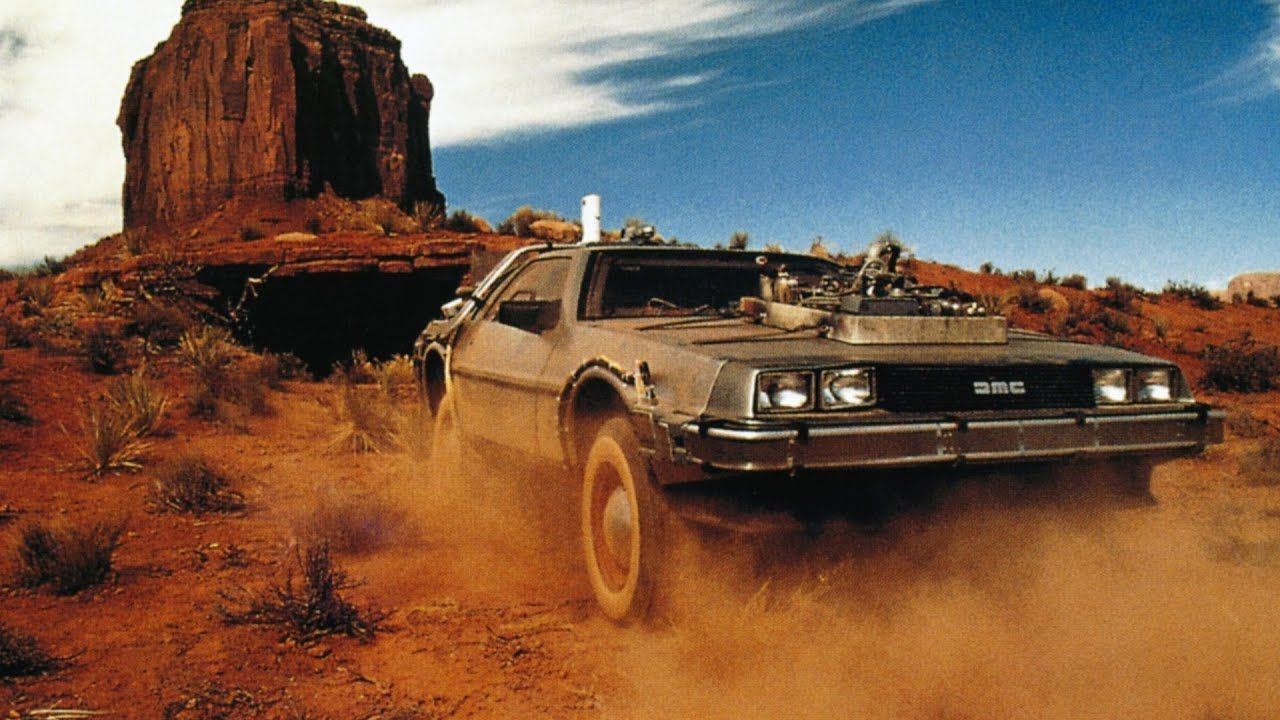
When Marty McFly (Michael J Fox) sees the time machine for the first time:
Marty McFly: “Wait a minute, Doc. Ah … Are you telling me that you built a time machine … out of a DeLorean?
Dr. Emmett Brown: “The way I see it, if you’re gonna build a time machine into a car, why not do it with some style?”
Spielberg used six DeLorean chassis for the production, and one manufactured out of fiberglass for scenes requiring a full-size on-screen flying vehicle.
Here’s where the car, all six versions, from Back to the Future is now.
Only Three Back To the Future Franchise Delorean Cars Remain
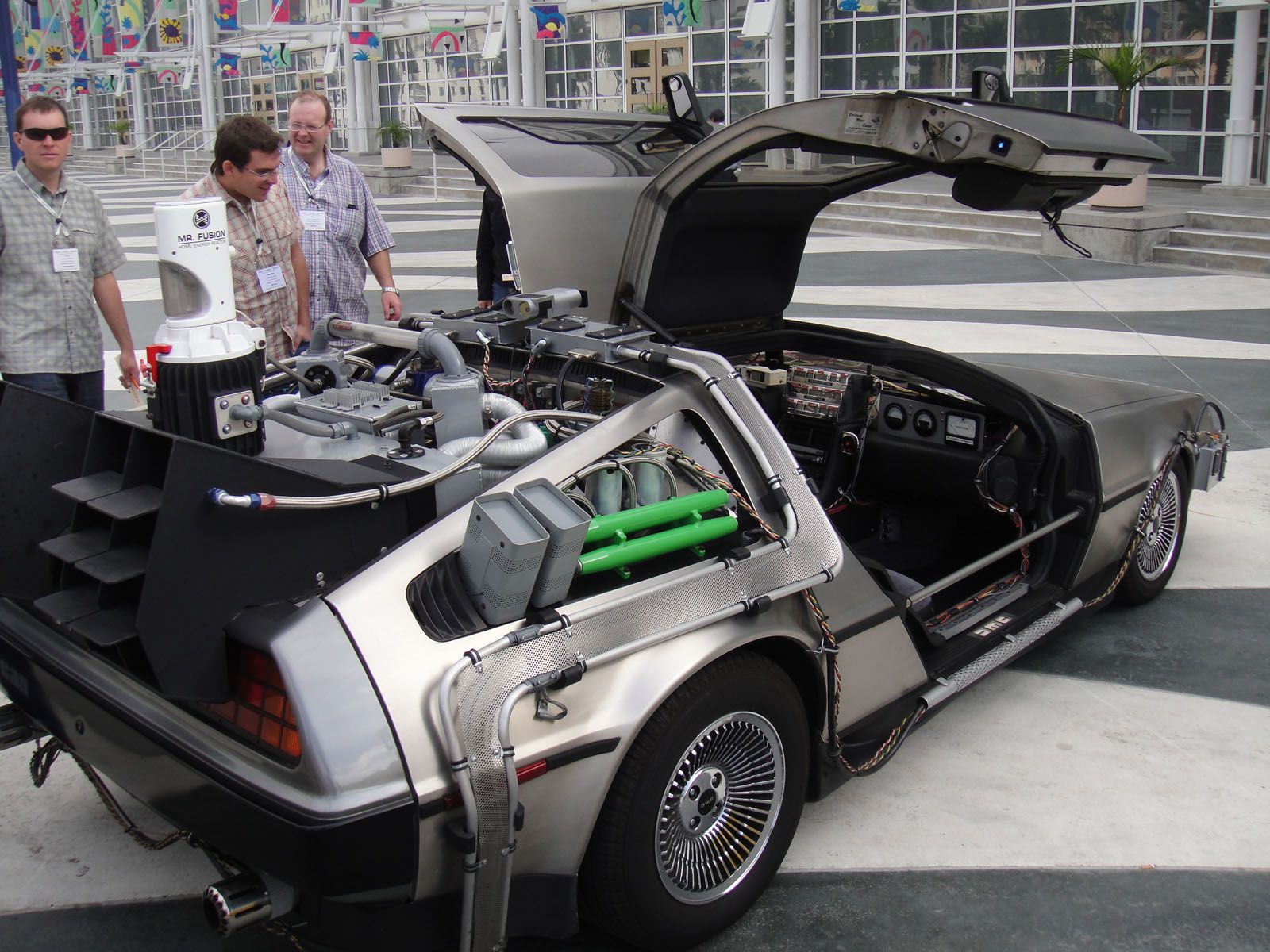
The Back to the Future DeLorean time machine used a flux capacitor to generate the 1.21 gigawatts of power required to reach 88 miles per hour and enter time travel.
Perhaps the producers felt the fictional device was necessary since the real-life DeLorean equipped with a Volvo engine was a notorious underperformer.
Film crews employed seven different vehicles throughout all three films. The Universal Studios special effects department built three principal DeLorean time machines and designated them the A, B, and C cars.
The A Car
The most detailed vehicle used during production was the “A” car, also known as the “Hero” car. When the filming of Back to the Future III finished, the vehicle was put on display at Universal Studios Hollywood. It was an ideal location for viewing, but some visitors could not resist removing parts and pieces, taking them home as souvenirs.
So, Bob Gale and his crew repaired the car, restoring it to near perfect condition and placed it in a clear display at Universal’s theme park, out of the reach of sticky-fingers visitors. The A car has since been moved to a new location.
The B Car
The “Wreckage” DeLorean (B car) was used primarily for stunts in all three films until it was intentionally struck by a train during the production of Back to the Future III.
Movie car customizer Jay Ohrberg used the remaining B car rubble to build several DeLorean replicas. Planet Hollywood Hawaii purchased the «B» car’s body panels and hung them from the restaurant’s ceiling until it permanently shut down in 2010.
The B car was rumored to have been purchased by Bill and Patrick Shea at auction for display in Hubbardston, Massachusetts. However, the father and son DeLorean on exhibit in their barn is a “screen-accurate” tribute to the original car used in the first “Back to the Future” movie.
Bill Shea commented: “Every effort was made to perfectly replicate exactly what you see in the 1985 movie…Six years ago, we took a perfectly good DeLorean and made it into a time machine.”
The C Car
The “C” car was partially disassembled to fit a camera and shoot interior footage.
While the DeLorean remained at Universal Studios Hollywood, many of its parts were used by Tom Talmon Studios to build a replica of the time machine for Universal Japan. A private enterprise purchased the DeLorean, and it is currently displayed in the company’s entryway.
Three Extra DeLoreans and a Fiberglass Model
Three extra DeLoreans were used through the production of the Back to the Future franchise.
The Oxnard Car has been on display at Universal Studios, Florida, from the early 1990s. A replica replaced the original car while it is in storage awaiting restoration.
The desert car with a blue cross over the tube remained at Universal Studios Hollywood, supplying parts to Tom Talmon Studios for the Universal Japan replica. The model has been re-acquired for restoration and auction.
The fiberglass version used for the film’s special effects was reportedly demolished.
Back to the Future DeLorean DMC-12 Sale Benefited Parkinson’s Research
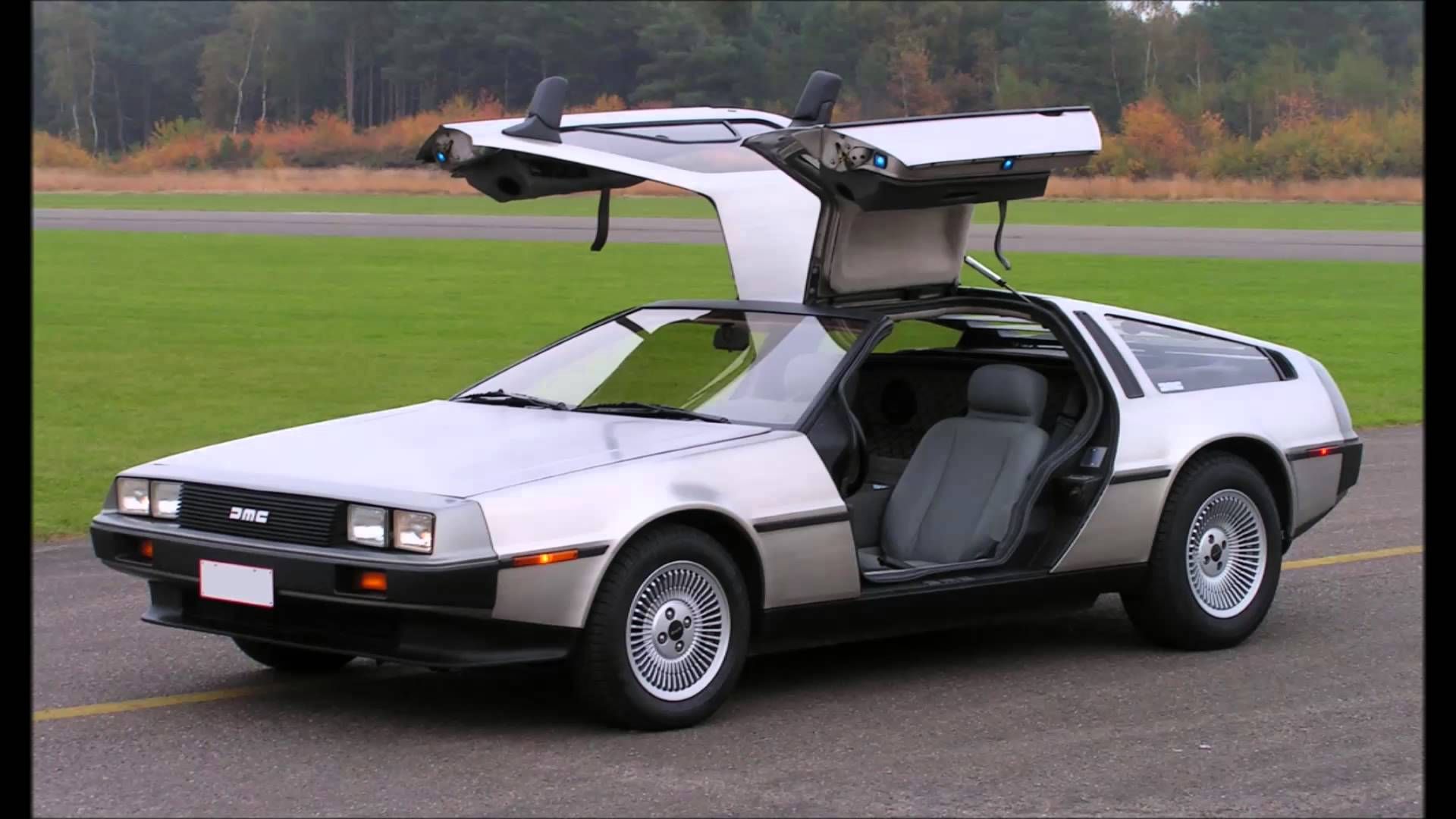
In 2020, 1981 DeLorean DMC-12 models typically sold for $30,000 to $60,000. The low-profile cars with unimpressive acceleration and handling command those prices mostly for their novelty and the model’s roles in the Back to the Future films.
A DeLorean model used in the films fetches a much higher price. In 2011, an original time machine complete with “flux capacitor” sold at auction for $541,200. The version auctioned had been fitted with a full roll-cage, a Volkswagen V-6 engine, and restored to the original movie specs. The proceeds of the auction benefited the Michael J. Fox Foundation for Parkinson’s Research.
No doubt, today, one of the three remaining original DeLorean time machines would sell at a much higher price.
Jay Leno Drives a $750,000 Replica of the Back to the Future DeLorean
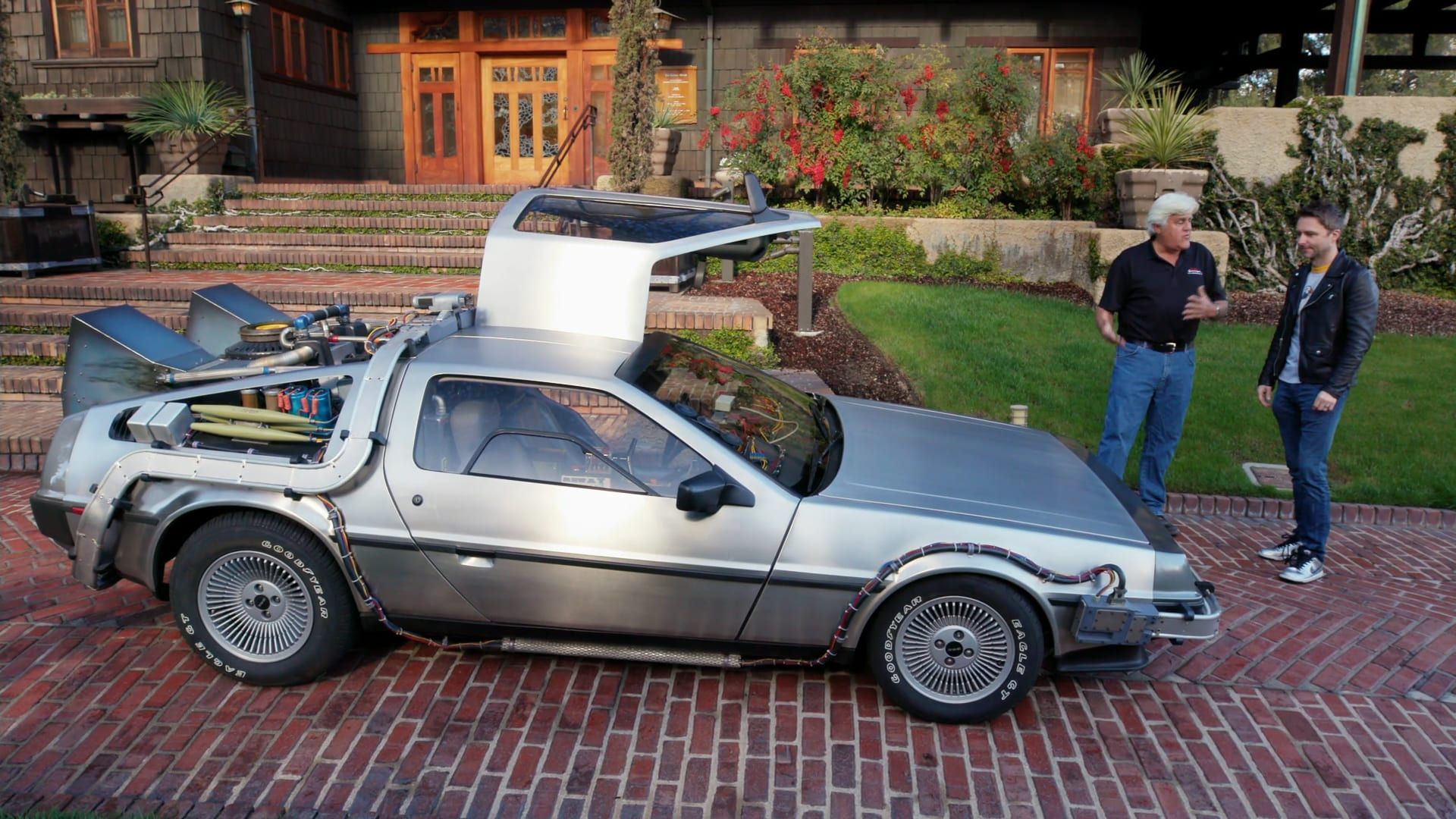
By 2020, the popularity of the Back to the Future films and the DeLorean time machine had spawned the creation of more than 150 replicas. Private auto customizers start with a stock car and add most, if not all, the props used in the films. The features include functional switches and indicator lights, along with the sounds which duplicate the movie car’s controls when activated. Most of the remodels are roadworthy with stock drivetrains.
One of the Back to the Future DeLorean replicas appeared on an episode of CNBC’s “Jay Leno’s Garage.” Jay and enthusiast Chris Hardwick, the host of NBC’s “The Wall” and ABC’s “Talking Dead,” go for a ride in the car equipped with flux capacitor and keypad time controls.
The two comedians discover some of the car’s weaknesses once they get behind the wheel. Hardwick comments, “It drives like s—, [and] there’s no power steering. Everything in here rattles.”
Despite the DeLorean’s limitations, the time machine replica is valued at $750,000.
The Back To The Future DeLorean On Display At The Petersen Museum
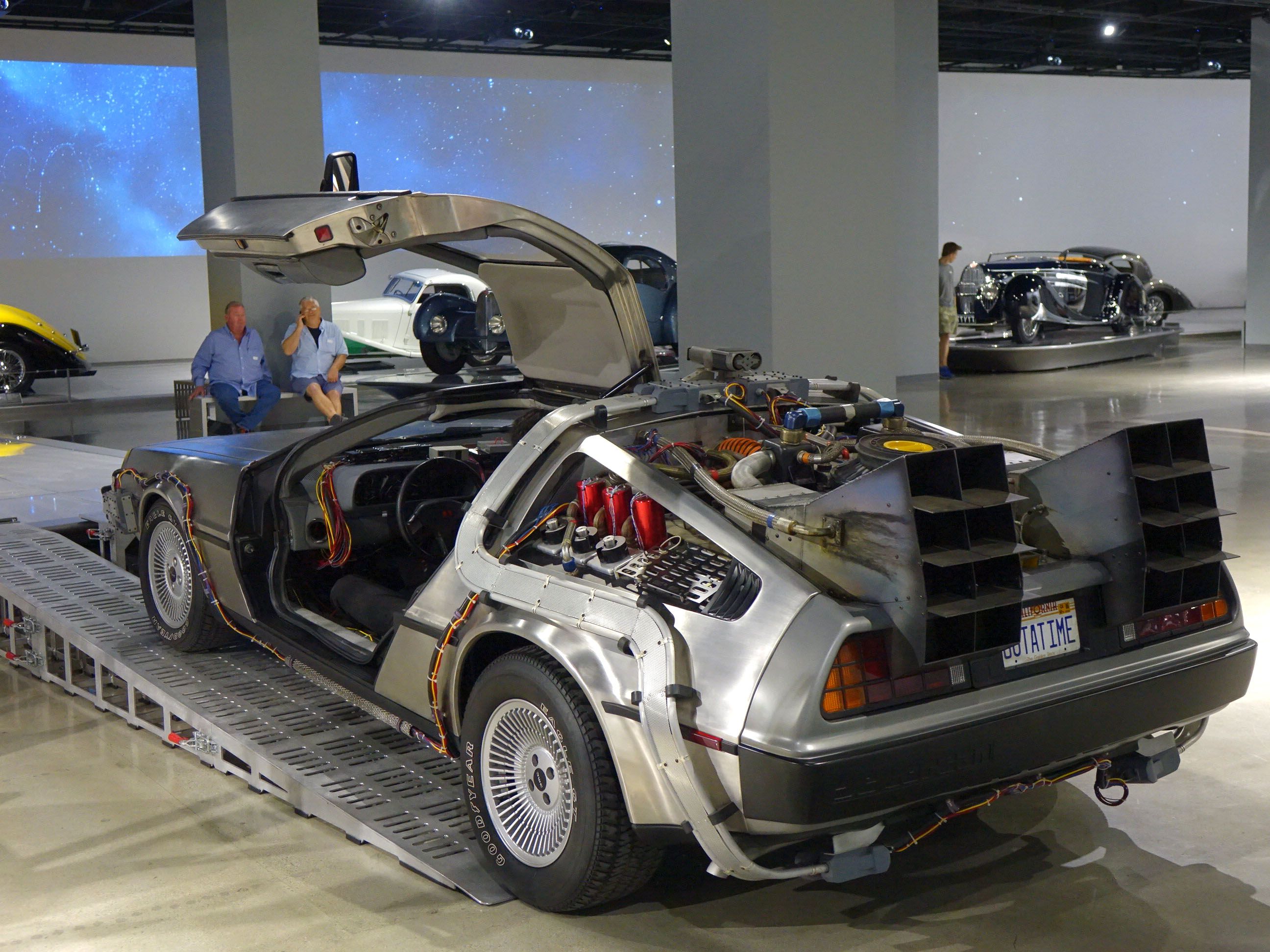
After a tour of Japan and some time spent in Universal Studios decaying in the weather and losing pieces to souvenir-seeking visitors, the “Hero” version Back to the Future DeLorean time machine was restored. The car now has a permanent home at the Petersen Museum in Los Angeles, California, on the third floor “Hollywood Collection” display with other cinematic icons.
Sources: discoverlosangeles.com, newsfeed.time.com, drivetrib.com, hollywoodreporter.com
NEXT: Here’s What Should Have Powered The DMC DeLorean
Части фильма «Назад в будущее» стали культовыми, но остались в прошлом. Многие полагают, что то же самое справедливо и для одного из главных героев трилогии – автомобиля DeLorean DMC-12. Но, оказывается, легенда жива – для тех, кто очень хочет в неё верить.
Вопреки стереотипу, DMC-12 не был посланником будущего – он был настоящим, с массой реальных проблем. В частности, он был жутко неудобным и весьма ломучим, особенно первые произведённые образцы. Тем не менее он остался абсолютной иконой – едва ли за всю историю автомобилизма наберётся больше двух-трёх десятков столь же узнаваемых машин.
Затерянный во времени
Мы уже рассказывали нашим читателям историю «классического» DeLorean – после череды громких скандалов, банкротства и последующего оправдания основателя компании DMC Motors Джона Делореана, один из самых запоминающихся автомобилей в истории, казалось бы, канул в Лету. Сам господин Делореан, пережив форменный кошмар с крахом дела всей его жизни (и, похоже, так до конца и не оправившийся от него), ушел из жизни в 2005-м в возрасте 80 лет.
Как до его смерти, так и после неё, упоминания о футуристическом DMC-12 модели 1981 года периодически всплывают в СМИ – чаще всего это происходит, когда реальность добирается до одной из дат, указанных в фильмах, сделавших автомобиль столь популярным. А иногда – когда один из уцелевших экземпляров автомобиля продаётся с аукциона.
Но помимо этих редких и громких сделок, Делореаны продаются и более прозаично – в Сети можно найти множество объявлений о продаже этих машин. И что интересно – крайне редко авто продаются частниками (DMC-12 – слишком культовая машина, чтобы покидать частные коллекции), в основном сбыт происходит от лица компании с названием… DeLorean Motor Company. Но как такое возможно? Ведь «аутентичная» DMC обанкротилась много лет назад! Назад в будущее?
Хьюстон, у нас проблемы
То самое будущее, о котором рассказывалось в голливудских фильмах 1980-х, оказалось вполне реальным в настоящем. В 1983 году имущество североирландского завода обанкротившегося DMC выкупила компания-ритейлер (в ту пору – Consolidated Stores Corporation, позднее Odd Lots, ныне Big Lots) из США со штаб-квартирой в Колумбусе, Огайо. Пару лет спустя осевший в Южной Калифорнии ливерпульский механик Стив Уайн начал в своей мастерской обслуживание автомобилей DeLorean – многие компоненты «конструктора», из которых был собран DMC-12, включая мотор PRV и трансмиссию Renault, были ему хорошо знакомы по другим автомобилям.
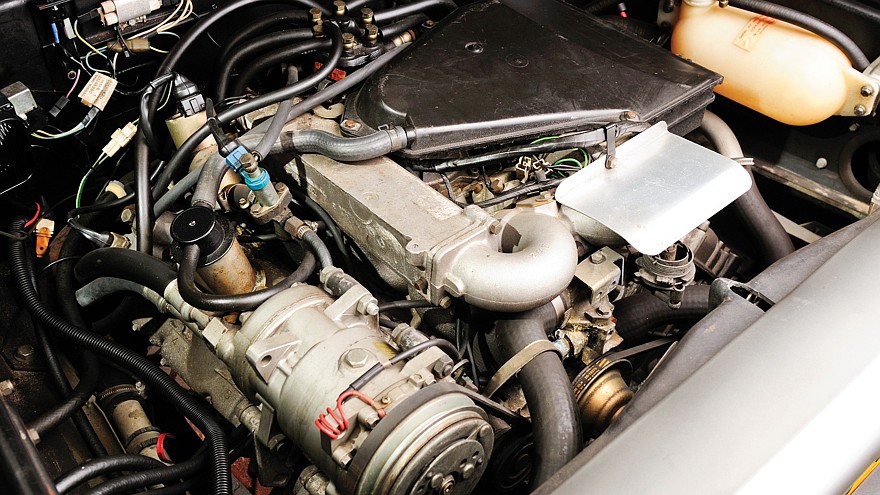
Оба обстоятельства были очень кстати, потому что способствовали хоть какому-то решению проблем с запчастями и обслуживанием, ведь было выпущено около 9 000 экземпляров автомобиля, а его владельцы в столь важном вопросе, как сервис (особенно для весьма капризного DMC-12) после краха компании остались предоставлены сами себе.
В 1985 году две сюжетные линии сошлись: Уайн основал общество владельцев автомобилей DMC-12 под названием DeLorean One, выкупил часть бывшего имущества Делореана – а именно обширный склад компонентов в Колумбусе – и наладил полноценное обслуживание автомобилей и доставку запчастей по почте. В 1988 году чтобы покрыть потребности растущей клиентской базы, он открыл второе представительство в Хьюстоне, штат Техас. С того времени технические проблемы владельцев автомобилей DeLorean были по большей части решены.

Почти как в кино
В 1995-м предприимчивый механик пошёл дальше и преобразовал общество DeLorean One в… компанию DeLorean Motor Company! Как утверждает сайт компании, в 1997 году Уайн приобрёл также и то, то осталось от оснастки, чертежей и прочих документов прежней компании, а также права на распространение продукции и канонический логотип «DMC». То, что начиналось как фан-клуб, превратилось в фирменный сервис и более того – сделало возможным даже сборку новых машин, полностью повторяющих оригинал.
В 2001–2002 годах компания построила новый объект на северо-востоке Хьюстона – на 40 000 квадратных футах (около 3 700 м²) разместились склад запчастей, выставочный зал, офисы, сервис-центр, сборочная площадка и зона для хранения 80 автомобилей. Туда на более чем 60 автопоездах было перевезено всё содержимое старого склада в Колумбусе, который был закрыт, а у компании начался новый период развития.
Практически с основания новой DeLorean Motor Company Уайн поступил очень по-американски и, в общем-то, весьма логично – наладил торговлю «мерчем», максимально используя легендарно-киношный образ машины: книги, плакаты, подарочные сертификаты, масштабные модели авто, одежда и обувь (совместно с Nike) с символикой DMC ныне имеют высокую ценность среди энтузиастов, а владельцам машин компания предлагает эксклюзивные напольные коврики, чистящие комплекты, чехлы на авто и ещё целый ряд аксессуаров.
В 2014 году у новой DMC возник конфликт со вдовой основателя марки – она утверждала, что товарный знак компании её покойного мужа по-прежнему принадлежит семье, никогда не был приобретён Уэйном и используется незаконно. Иск вдовы был урегулирован в досудебном порядке за некоторую сумму денег, которая осталась неизвестной широкой публике. Теперь право «новой» DMC использовать оригинальное название, торговую марку и логотип сомнению не подлежит.
Конструкция и технология
Даже в США, где базируется DMC, бытует заблуждение, что запчасти на Делореаны либо слишком дороги, либо вовсе недоступны. Однако большая часть техасской базы компании отдана именно под складские помещения, где находится порядка 1 982 деталей, узлов и целых агрегатов DMC-12, включая кузовные панели, элементы салона, стёкла, двигатели и коробки передач.
Около 90% всех компонентов (свыше 2 800 мелких деталей) являются так называемыми NOS-запчастями (New Original Parts), то есть произведёнными ещё при прежней DMC, но находящимися в идеальном состоянии. Остальное – это так называемые OEM-запчасти, то есть по-прежнему выпускаемые поставщиками DMC – свечи зажигания, компоненты системы впрыска и многое другое. Производство около 250 позиций было восстановлено в поздних 1990-х после создания новой компании.
Конструкцию машины много раз точечно дорабатывали на предмет повышения надёжности, но большинство огрехов ранних Делореанов было связано с поспешностью и небрежностью сборки, чего теперь вполне получается избежать. В целом же философия машины осталась прежней: «вечная» стальная рама, покрытая полимерной смолой, на которую крепятся стеклопластиковые панели, усиленные полиуретановой пеной, а поверх них – внешние кузовные детали, как и прежде полностью лишённые какой-либо окраски, потому как изготовлены из шлифованной нержавеющей стали.
А что с мотором? Оригинальный 130-сильный V6 серии PRV – это плод совместной работы Peugeot, Renault и Volvo (отсюда и название). Он стоял под капотом массы больших французских машин, а также шведских «чемоданов» 200-й и 700-й серий. Поначалу при сборке новых авто использовали исключительно «стоковые» PRV, но позднее на возрождённом DMC-12 применяли также агрегаты Cadillac Norstar с «автоматом» и различные тюнинговые варианты обоих двигателей, как атмосферные, так и турбированные. На момент написания статьи раздел «Двигатель, подвеска и апгрейд» на официальном сайте пустует – что и не слишком удивительно, учитывая, что средний объём выпуска новых Делореанов очень невелик, и подход к каждому клиенту, таким образом, строго индивидуален.
Клуб путешественников во времени
Однажды знаменитый учёный Стивен Хокинг устроил вечеринку, куда пригласил «гостей из будущего», но на неё никто не пришёл. Клуб обладателей автомобилей DeLorean несколько более густонаселённое сообщество, но не намного. На сегодня DMC насчитывает пять филиалов: в Техасе, Иллинойсе, Вашингтоне, Флориде и Калифорнии.
Силами этих отделений осуществляется сервис, продажа запчастей и аксессуаров, а также сборка и продажа новых автомобилей. Производственные мощности компании далеки от серьёзных объёмов выпуска – с конца 1990-х они позволили выпускать в среднем около 17 машин в год. И хотя с официального начала мелкосерийной сборки в 2008-м делается порядка 20-30 авто ежегодно, за всё время существования «новой» DMC выпущено всего немногим более 250 экземпляров DeLorean.
Компания продаёт как собственноручно собранные DMC-12, так и доставшиеся «в наследство» или перекупленные у прежних владельцев и тщательно восстановленные. «Бэушные» Делореаны в хорошем состоянии обойдутся в сумму от 25 000 долларов, а за собранные специально для вас «с нуля» просят от 58 000 до 73 000 долларов. Зато с помощью Гугл Карт можно совершенно бесплатно совершить виртуальную экскурсию по базе DMC в Хьюстоне, где расположены офисы, производство, склад и музей компании.
Сейчас по дорогам мира бегает несколько тысяч Делореанов – благодаря своей крепкой основе большая часть из когда-либо произведённых машин имеет большие шансы добраться до довольно отдалённого будущего.
И уж точно нельзя сказать, что автомобили из трилогии «Назад в будущее», как и сам бренд DMC, безнадёжно застряли в настоящем, которое неминуемо становится прошлым. Будущее у марки все же есть.
Поднятая в начале 2016 года шумиха вокруг «Делореана нового поколения» оказалась фейком – компания официально пояснила, что опубликованная в интернете картинка является нарисованной ещё в 2011-м «современной интерпретацией» De Tomaso Mangusta с прилепленным к ней значком DMC и никакого отношения к DeLorean не имеет. Зато с 2012 года идёт разработка электрической версии DMC-12. Неизвестно, когда электрокар можно будет купить. На такие вопросы компания, не рискуя быть непонятой, вполне может отвечать – в будущем!
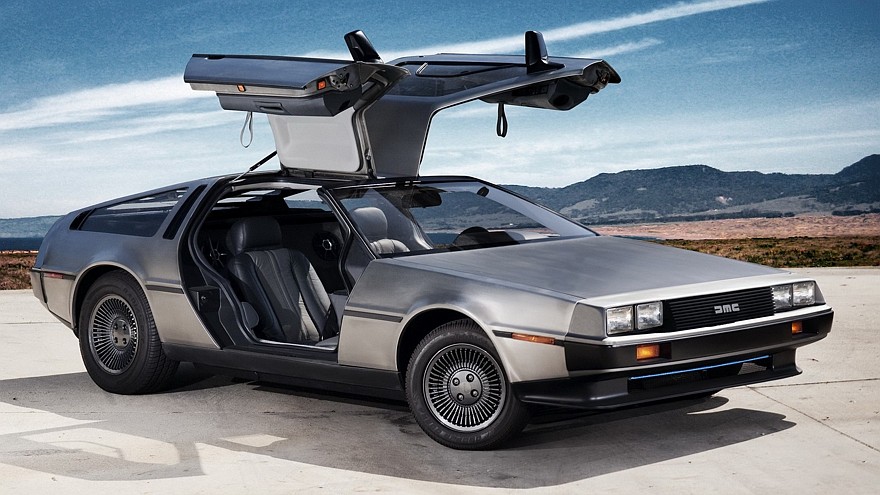
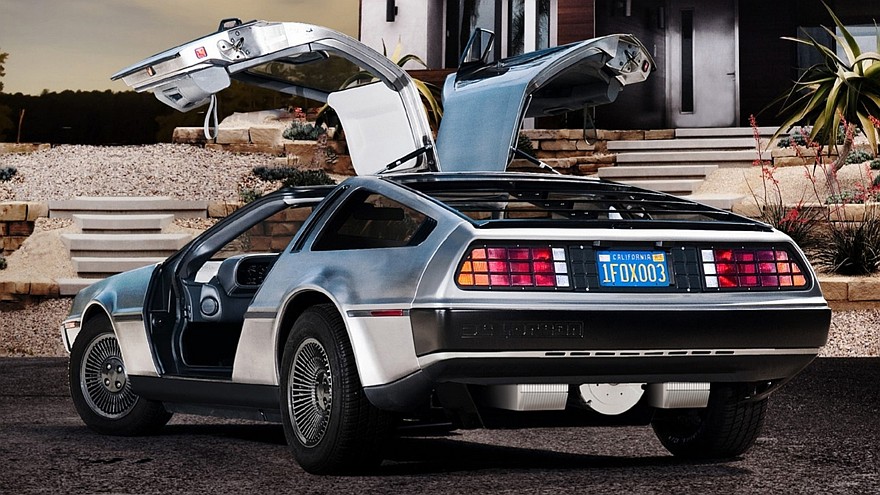
PS: другие машины времени
Так здорово однажды узнать, что часть твоего детства, юности или давних мечтаний возможна в реальности. Вот всего несколько примеров: в Англии главным источником дохода компании Caterham по-прежнему остаётся классический родстер Seven, на Туманном Альбионе осуществляют и мелкосерийную сборку самого маленького автомобиля в мире, Peel P-50, который родом из 1960-х, в Германии делают реплики столь же миниатюрных классических Mopetta, в США, как мы теперь знаем, базируется производство великолепных DeLorean…
Там же, в Штатах, в «нулевых» собирали электромобили Oka NEV ZEV на базе автомобиля ВАЗ-1111 Ока, да и исконно советский бренд «Урал» ныне производит эксклюзивные мотоциклы для США, внешне практически полностью повторяющие байки из СССР, но более совершенные технически… Словом, чтобы путешествовать по четвёртому измерению, необязательно иметь машину времени – было бы желание.
А реально ли в России наладить мелкосерийную сборку, скажем, реплик «двадцать четвёртой» Волги, «четыреста двенадцатого» Москвича или «единички» Жигулей? Едва ли – чтобы такое произошло, должно совпасть очень много факторов. Для реалий российского бизнеса и для российского менталитета – слишком много. Для нас те самые автомобили, которые многие считают настоящими, навсегда остались в прошлом.
Опрос
Вы бы себе хотели DeLorean?
В США найден один их ранних экземпляров DeLorean DMC-12 из «Назад в будущее»
Автомобиль DeLorean DMC-12 обнаружили в старом сарае в Нью-Мексико (США). Об этом сообщает motor1.com. Такая машина участвовала в съемках известной трилогии «Назад в будущее».
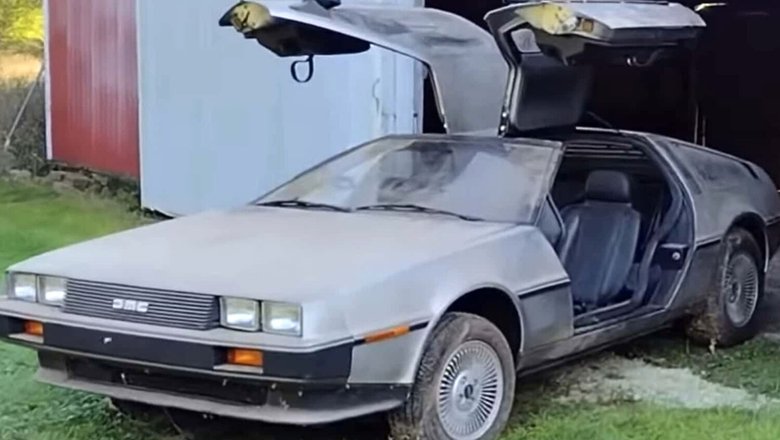
Отмечается, что на момент обнаружения одометр редкой машины показывает всего 977 миль (1572 км). Найденный автомобиль является одним из первых выпущенных DeLorean. Спорткар сошел с конвейера в 1981 году. Кузов и мотор находятся в хорошем состоянии. Автомобиль в ближайшее время будет восстановлен.
Первый прототип DeLorean DMC-12 был разработан в 1977 году. Выпуск серийной версии спортивного купе был налажен в Северной Ирландии в 1981 году.
В августе 2022 года DeLorean Motor Company (DMC) впервые показала на публике электромобиль Alpha5, который стал преемником модели DMC-12.
Машина получила двери с подъемным механизмом типа «крыло чайки», узкие светодиодные фары, большие колеса с низкопрофильными шинами.
| DeLorean Time Machine | |
|---|---|
| Back to the Future franchise element | |
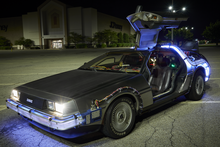
Side view of a replica of |
|
| Publisher | Amblin Entertainment |
| First appearance |
|
| Created by | Robert Zemeckis Bob Gale |
| Genre | Science fiction |
| In-universe information | |
| Type | Time machine |
| Function | Allows the occupants to travel through time along with the car |
| Affiliation | Marty McFly Emmett Brown |
In the Back to the Future franchise, the DeLorean time machine is a time travel vehicle constructed from a retrofitted DMC DeLorean. Its time travel ability is derived from the «flux capacitor», a component that allows the car to travel to the past or future (though not through space). This occurs when the car accelerates to 88 miles per hour and requires 1.21 «jigowatts» of electricity.
In 2021, the time machine was added to the Library of Congress’s National Historic Vehicle Register.[1]
Operation[edit]
The control of the time machine is the same in all three films. The operator is seated inside the DeLorean (except the first time, when the remote control is used), and turns on the time circuits by turning a handle near the gear lever, activating a unit containing multiple fourteen- and seven-segment displays that show the destination (red), present (green), and last departed (yellow) dates and times. After entering a target date with the keypad inside the DeLorean, the operator accelerates the car to 88 mph (142 km/h), which activates the flux capacitor. As it accelerates, several coils around the body glow blue/white while a burst of light appears in front of it. Surrounded by an electric current similar to a Tesla coil, the whole car vanishes in a flash of white/blue light seconds later, leaving a pair of fiery tire tracks. A digital speedometer is attached to the dashboard so that the operator can accurately gauge the car’s speed.
Various proposals have been brought forth in the past by fans of the movie franchise for why the car has to be moving at 88 mph to achieve temporal displacement,[2] but actually the production crew chose the velocity simply because they liked how it looked on the speedometer, modified for the movie.[2] The actual speedometer on the production DeLorean’s dashboard only goes up to 85 mph, and the car itself was criticized for being underpowered.
Observers outside the vehicle see an implosion of plasma as the vehicle disappears, leaving behind a trail of fire aligned with the DeLorean’s tires (which can also appear in midair), while occupants within the vehicle see a quick flash of light and instantaneously arrive at the target time in the same spatial location (relative to the Earth) as when it departed. In the destination time, immediately before the car’s arrival, three large and loud flashes occur at the point from which the car emerges from its time travel. After the trip, the exterior of the DeLorean is extremely cold, and frost forms from atmospheric moisture all over the car’s body. Vents on the back heat the vehicle after time travel.
The DeLorean suffers assorted malfunctions and damage over the course of the trilogy. In the first film, the car has starter problems and has a hard time restarting once stopped, much to Marty’s repeated frustration.[3] In the second film, the destination time display malfunctions and begins to show a series of random dates, causing Doc to be sent back to 1885 when the DeLorean is struck by lightning with him inside.[4] In the third film, a note left by Doc’s 1885 self reveals that the DeLorean’s flying circuits (added by him in 2015) were destroyed by the strike. After Marty travels back to 1885, the fuel line and fuel injection manifold both suffer damage, leaving the car unable to move under its own power.[5]
The time machine is electric and requires a power input of 1.21 gigawatts (1,620,000 hp) to operate, originally provided by a plutonium-fueled nuclear reactor. In the first film, following Marty’s accidental trip from 1985 to 1955, Doc has no access to plutonium in 1955, so he outfits the car with a large pole and hook in order to channel the power of a lightning bolt into the flux capacitor and send Marty back to 1985.[3] During Doc’s first visit to 2015, he has the machine refitted to fly in addition to standard road driving, and he replaces the nuclear reactor with a Mr. Fusion generator that uses garbage as fuel.[3][4]
Although the Mr. Fusion unit provides the required power for the time machine, the DeLorean is still powered by an internal combustion engine for propulsion. The fuel line is damaged during Marty’s trip to 1885 in Back to the Future Part III. After he and Doc patch it, they attempt to use whiskey as a replacement fuel since commercial gasoline is not yet available. The test fails, damaging the car’s fuel injection manifold and leaving it unable to travel under its own power.
Doc and Marty consider options to reach the required 88 mph (such as pulling it with horses, which fails because the car barely breaks 30 mph) and ultimately settle on pushing the car with a steam locomotive. They replace the DeLorean’s standard wheels with a set designed to mate with train rails. For the extra power needed to push it up to speed, Doc adds his own version of «Presto Logs» (a chemically treated mixture of pressed wood and anthracite) to the locomotive’s boiler and chooses a location with a straight section of track long enough to achieve 88 mph.[5]
Jigowatts[edit]
The power required is pronounced in the film as «one point twenty-one jigowatts»,[3] with a jigowatt referring to «one billion watts». The spelling of jigowatts is used in the script[6] and was also the spelling used in the closed-captioning in earlier home video versions of the film. However, the correct spelling is «gigawatts». Although rarely used, the «j» sound at the beginning of the SI prefix «giga-» is an acceptable pronunciation.[7][8] Later versions of closed captioning, such as in the 2020 DVD Trilogy release have corrected the spelling to gigawatts. In the DVD commentary for Back to the Future, Bob Gale states that he had thought it was pronounced this way because it was how a scientific adviser for the film pronounced it.[9] The «jigowatts» spelling is used by Alan Dean Foster in the novelizations of the second and third films.
Equipment[edit]
Flux capacitor[edit]
The flux capacitor, which consists of a rectangular-shaped compartment with three flashing Geissler-style tubes arranged in a «Y» configuration, is described by Doc as «what makes time travel possible». The device is the core component of the time machine.[3]
As the time machine nears 88 mph, light coming from the flux capacitor begins pulsing more rapidly until it becomes a steady stream. Doctor Emmet Brown originally conceived the idea for the flux capacitor on November 5, 1955, when he slipped on the edge of his toilet while hanging a clock in his bathroom and hit his head on the sink. In 1955 «Doc» had named the flux capacitor the «Flux Compresser» as shown on 1955 «Doc’s» diagram.[3] A similar flux capacitor is also seen in the chimney headlamp of Doc’s second time machine, the Time Machine Locomotive, at the end of Back to the Future Part III.[5]
Although the films do not describe exactly how the flux capacitor works, Doc mentions at one point that the stainless steel body of the DeLorean has a direct and influential effect on the «flux dispersal», but he is interrupted before he can finish the explanation.[3] The explanation is finished in BTTF’s «Delorean Time Machine; Doc Brown’s Owners’ Workshop Manual», which says «However, the stainless-steel construction of the DeLorean would serve to make the Flux Dispersal uniform across the entire surface area of the vehicle.»[10]
The instruction manual for the AMT/ERTL DeLorean model kit also states: «Because the car’s stainless steel body improves the flux dispersal generated by the flux capacitor, and this in turn allows the vehicle smooth passage through the space-time continuum».[11]
Time circuits[edit]
The time circuits are an integral part of the DeLorean time machine. They were built with an input device and a display. The display was divided into three sections: destination time (shown in red), present time (shown in green), and last time departed (shown in yellow), all annotated with Dymo labels. Each display includes a month, a day, a year, and the hour and minutes in that point in time. The years on the time circuits were limited to four digits and there were no possible negative years that could be reached, i.e. years before «0 A.D.» (1 B.C.). This means the DeLorean could travel to any time from 12:00 am on January 1, 1 B.C. to 11:59 p.m. on December 31, A.D. 9999.[non-primary source needed]
The destination time display shows the date that the operator wants the DeLorean to go to (when the operator types in a date using the keypad in the DeLorean, it will be shown in the destination time display), the present time display shows the DeLorean’s current location in time, and the last time departed display shows what point in time the DeLorean originally was after making a journey through time. Doc demonstrated its capabilities to Marty after its first test, giving two well-known but erroneous dates as examples: the signing of the Declaration of Independence, July 4, 1776; and the birth of Christ, December 25, 0000. He also displayed the day that he first conceived of the flux capacitor, by which he marks the day he invented time travel, November 5, 1955, as he explains to Marty in the beginning of the first film.[non-primary source needed]
During the second film, because of Biff Tannen’s tampering[12] following his theft of the DeLorean, the time circuits began malfunctioning, displaying January 1, 1885, in the destination time display. A bolt of lightning triggers the malfunction to send the DeLorean from 1955 to 1885. Though the vehicle was in mid-air, the spin created by the lightning bolt allowed it to reach 88 mph. Doc is trapped in 1885 and repairs were impossible because the time circuit control microchip, which governed the time circuits, was destroyed by the lightning bolt, and suitable replacement parts would not be invented until at least 1947. Doc places repair instructions and a schematic diagram in the time machine to enable his 1955 counterpart to repair it using components from that era — which included vacuum tubes — before boarding it up within a silver mine. He then writes Marty a letter explaining the situation and places it in the custody of Western Union, with instructions to deliver it to Marty in 1955.[non-primary source needed]
Mr. Fusion[edit]
The Mr. Fusion Home Energy Reactor is the name of a power source used by the DeLorean time machine in the Back to the Future trilogy. It can be seen for the first time at the end of Back to the Future when Doc pulls into the McFly’s driveway after a trip to the year 2015. It is a parody of Mr. Coffee machines, which were very popular at the time of filming.[13] The appliance from which the prop was made was actually a Krups «Coffina» model coffee grinder.[citation needed]
The Mr. Fusion Home Energy Reactor converts household waste to power for the time machine’s flux capacitor and time circuits using nuclear fusion, presumably cold fusion. In the film, Mr. Fusion allows the DeLorean time machine to generate the required 1.21 gigawatts needed to travel to any point in time. The energy produced by Mr. Fusion replaces plutonium as the primary power source of the DeLorean’s time travel, allowing the characters to bypass the arduous power-generation requirements upon which the plot of the first film hinges. The plutonium fission reactor was most likely left installed underneath Mr. Fusion as a backup power source.[3][4]
The Mr. Fusion can provide enough power to the flux capacitor and the time circuits, but is not used to power up the DeLorean itself, which makes use of an ordinary gasoline combustion engine to reach the 88 mph speed necessary for it to time travel. This limitation proved crucial in the third movie when Doc and Marty find themselves stuck in 1885 and unable to drive the DeLorean due to a punctured fuel line. The vehicle’s hover system is powered by Mr. Fusion and is capable of bringing the DeLorean up to the required 88 mph. However, the flight systems are destroyed as a result of the lightning strike that occurs at the end of the second film, leaving Marty to rely on the original combustion engine, which is also disabled until Doc fixes it in 1885.[non-primary source needed]
Other equipment[edit]
Besides the flux capacitor, the time circuits, and the Mr. Fusion chamber, the DeLorean had numerous other equipment that aid its ability to function: a keypad used to type in a target date, a lever that activates the time circuits, a pair of vents on the back that heat the vehicle after it travels through time, a plutonium chamber that serves as its original power source before being replaced by Mr. Fusion, and a wormhole emitter on the roof that helps the car travel through time via wormholes. Doc had also built a special remote that can control the car, although it was only used once. After it ended up in 1955, the DeLorean received a few additional equipment: an alarm clock that 1955 put in its dashboard to signal Marty when it is time to speed towards the clock tower, and a hooked pole used to channel a lighting strike into the flux capacitor. After the DeLorean disappears to 1985, the pole remained behind in 1955.[non-primary source needed]
In 2015, the DeLorean was given the ability to fly along with a barcode license plate to replace its old one. In the third film, after Marty and 1955 Doc recovered the DeLorean from the mines, a vacuum tube circuit was installed on the front hood to restore its time traveling ability. 1955 Doc also replaced the rotted away tires with whitewalls. Once in 1885, the DeLorean had one final set of modifications: the tires were again replaced with train wheels and a boiler temperature gauge that’s connected to the stolen locomotive’s boiler is installed in the dashboard.[non-primary source needed]
Fictional timeline[edit]
For most of the first film, the 1.21 gigawatts are supplied by a plutonium-powered nuclear fission reactor and, with the absence of plutonium, a bolt of lightning channeled directly into the flux capacitor by a long pole and hook in the film’s climactic sequence.[3] At the end of the first film, and for the remainder of the trilogy, the plutonium nuclear reactor is replaced by a «Mr. Fusion Home Energy Reactor» generator possibly acquired in 2015.[4] The «Mr. Fusion» device apparently converts household waste into electrical power; the name suggests nuclear fusion. Due to a «hover conversion» made in 2015, the car also becomes capable of hovering and flight, though it lost this ability at the end of the second film.[4][5]
History[edit]
After acquiring the DeLorean and modifying it into a time machine, Doc brings it to the Twin Pines Mall and tests it out by using a remote control to send it one minute into the future with his dog Einstein in it. He also shows Marty the major functions of the DeLorean: the flux capacitor, the time circuits, and the plutonium chamber that powers them. After refueling the DeLorean with plutonium stolen from Libyan terrorists (who previously stole the plutonium from a power plant), Doc prepares to travel into the future, but the Libyans unexpectedly arrive and shoot Doc. Marty uses the DeLorean to flee from the Libyans and is transported to 1955 after accidentally activating the time circuits, but without the needed plutonium. Once there, the DeLorean exhibits problems with the starter, and with its plutonium chamber empty, Marty hides the DeLorean behind a road sign and contacts the Doc Brown living in 1955. The two bring it to Brown’s workshop.[non-primary source needed]
Unable to obtain plutonium, Doc and Marty realize, from a fundraising flyer given to Marty earlier in the film, that the only source for the power needed to return the DeLorean to 1985 is a bolt of lightning that they know from history will strike Hill Valley Courthouse’s clock tower at a particular moment in the next few weeks. Doc installs a cable leading from the top of the clock down to the street to harness the lightning, and attaches a long pole and hook to the DeLorean to channel the energy into the flux capacitor once the hook makes contact with the cable while the DeLorean is accelerating at 88 mph. Despite setback involving the cable being disconnected by a fallen branch and the DeLorean having starter problems again, the plan succeeds, and Marty returns home, arriving ten minutes before he left 1985 to warn Doc of his upcoming death since 1955 Doc wouldn’t listen out of fear of changing history. With the DeLorean once again having issues with the starter, Marty is forced to run to the Twin Pines Mall, now called the Lone Pine Mall due to his actions in 1955. He is too late as Doc is gunned down while his other self escapes to 1955, leaving the Libyans to crash into a photo booth, but it is revealed that Doc wore a bulletproof vest and had listened to Marty’s warning after all.[non-primary source needed]
After returning Marty home, Doc travels with Einstein to October 21, 2015, where he upgrades the DeLorean with 2015 technology, replacing the plutonium chamber with a Mr. Fusion Reactor, and giving it the ability to fly. In the second film, he returns to 1985 to pick up Marty and Jennifer, telling them that they have to rectify a problem caused in the future when Marty’s son commits a crime. While there, the DeLorean is stolen by Biff Tannen, who discovers that it is a time machine, and uses it to travel back to November 12, 1955, the same day as the climax of the first film, to give his past self a sports almanac the young Biff uses to accumulate wealth from gambling. Biff returns the DeLorean to 2015, without Marty or Doc discovering his use of it until they return to 1985, which due to Biff’s manipulation of history, has been transformed into a post-apocalyptic alternate timeline in which Biff is a wealthy casino boss and crime lord. Discovering from that this was caused by older Biff’s use of the DeLorean and the almanac, Marty and Doc return to 1955 to prevent the younger Biff from acquiring it, thus restoring the original timeline.[4] They manage to take back and destroy the almanac and destroy it, but the DeLorean, with Doc inside it, is struck by lightning again, this time by accident, and due to a malfunction in the time circuits, and disappears. Unbeknownst to Marty, Doc is transported to January 1, 1885. Both the DeLorean’s time circuits and flying capability are disabled in the process, though not the internal combustion engine.[4][5]
Because suitable replacement parts to repair the DeLorean will not be invented until 1947, Doc hides the DeLorean in a mine, and leaves a letter to be delivered to Marty by Western Union in 1955, in which he explains what happened to him. Doc states he is happy in his new life there as a blacksmith, and requests that Marty not attempt to retrieve him, but instead to return to 1985 and destroy the DeLorean, believing that it has brought them and the world nothing but disaster. However, Marty and 1955 Doc learn that just nine months after arriving in 1885, Doc will be murdered by Biff’s great grandfather, Buford «Mad Dog» Tannen, on September 7, 1885. For this reason, the 1955 Doc and Marty agree to have Marty travel back in time to 1885 to prevent Doc’s murder. After retrieving the DeLorean from the mine, repairing its time-travel ability, and replacing its since-disintegrated tires with whitewalls (although they could not restore its flight systems), Marty travels to 1885, but the DeLorean’s fuel line is damaged soon after he arrives there. After encountering his ancestors, Marty decides to use the alias Clint Eastwood. After meeting up with the 1885 Doc, the fuel line is repaired, but their experiments with creating modern fuel from whiskey destroys the fuel injection manifold, leaving the car unable to travel under its own power. After trying a few ideas (such as pulling it with horses), they resolve to use a steam locomotive to push the DeLorean up to 88 mph. They learn that in order for the locomotive to reach 88 mph, the run would have to be on a flat, straight track with no cars coupled behind it and with the boiler’s temperature risen to dangerous levels. Doc replaces the 1955-style wheels with cast iron train wheels that fit on the track rails.[non-primary source needed]
Doc and Marty plan to make their run on a flat, straight section of track leading to an unfinished bridge over Shonash Ravine. While making their plans, Doc saves schoolteacher Clara Clayton from falling into Shonash Ravine. They realize in the original timeline, Clara fell to her death in the ravine, which was renamed Clayton Ravine. After her rescue, Doc and Clara begin to fall in love. Marty and Doc continue their plan, in which the Mr. Fusion unit will provide the power required to activate the flux capacitor and make the jump through time once the stolen locomotive and the DeLorean reach 88 mph.[5] Their plan is successful, and upon reaching the end of the track, the DeLorean disappears to 1985 with Marty, though Doc decides to stay behind with Clara. The locomotive falls down the cliff and is destroyed.[non-primary source needed]
Back in 1985, the DeLorean arrives on the now-completed bridge and crosses over the ravine, now called Eastwood Ravine on account of his exploits in 1885. The DeLorean becomes stuck on the tracks, and Marty barely manages to escape before the DeLorean is completely destroyed by a freight train. Later, Doc, Clara, and their children: Jules and Verne, appear in the same location where the DeLorean was destroyed, piloting a new time machine in the form of a steam-powered train. After picking up Einstein, the couple and their children depart for an unknown time period.[non-primary source needed]
Other elements[edit]
In the films, the DeLorean time machine is a licensed, registered vehicle in the state of California, where the films take place. The vanity license plate used in the film reads «OUTATIME», a deliberate anomaly, as the maximum number of symbols on California plates is seven characters.[3] When Doc returns from 2015, it is a barcode license plate.[3][4]
Animated series[edit]
In The Animated Series, Doc builds another DeLorean into a time machine, restoring most of its features, including Mr. Fusion and the hover conversion (Doc either rebuilds the one destroyed at the end of Part III or he simply builds a new one). He also seemingly adds the capability to travel through space in addition to time (i.e., appear at a different location from the one it departed), similar to the TARDIS from Doctor Who. The cartoon DeLorean time machine has many add-ons, including a back seat in normal two-door mode, the ability to transform into a four-door, a pop-out covered wagon top, a blimp, a rear video screen, and a voice activated time input.[non-primary source needed]
Back to the Future: The Game[edit]
Back to the Future: The Game features a chronal duplicate of the original DeLorean, which Doc Brown recovered from the timestream after the destruction of the original. This DeLorean is created at the end of Back to the Future Part II; when the original time machine was struck by lightning: while the DeLorean itself is sent to 1885, a fully functional duplicate appears (apparently unmanned and undamaged) in 2025, where Doc retrieves it with the Time Train before Griff Tannen could. This Clone DeLorean is effectively the same as the Part II one, including the occasional glitches in the time circuits (mostly affecting the last time departed time display), but with a new automatic retrieval feature that automatically brings the Clone DeLorean to a set time and location of Doc’s choosing every time Doc doesn’t return to the car in a fixed amount of time. The original DeLorean made a brief appearance in Marty Mcfly’s nightmare where Doc sends it one minute into the future, which copies the events of the first film. The only difference is that it does not return from its one-minute trip.[14]
The Clone DeLorean appears outside of Doc’s house after Marty recovers Doc’s notebook from Biff Tannen. Inside is Einstein, a tape recorder with a message from Doc that tells Marty about the automatic retrieval system, and a mysterious shoe. After learning that Doc is stuck somewhere in time, he activates the time circuits, but the last time departed time display is faulty, forcing Marty to use Einstein and the shoe to find out Doc’s whereabouts. He eventually learns that Doc is in 1931 and will be killed by Irving «Kid» Tannen, Biff’s father. Marty travels to 1931, one day before Doc’s death, appearing in the middle of a police chase (the glitch in the time circuits is resolved after the police car bumps into the Clone DeLorean). After getting away from the police, he hides the Clone DeLorean behind a sign.[non-primary source needed]
After rescuing Doc, they prepare to return to 1986, but Marty discovers that he is disappearing; it turns out his grandfather Artie Mcfly will be killed by Kid as a result of Marty’s earlier actions. Upon being caught by Officer Danny Parker, Marty swipes the DeLorean keys and travels several hours back (with Doc staying behind) to rescue Artie from Kid to ensure his existence before he and Doc return to 1986, but find themselves in a dystopian future which was brought into existence due to Kid not being arrested. Marty and Doc return to 1931 to correct the timeline (Doc hides the DeLorean in the DeSoto Lot to ensure that no one can find it and later uses it to get Einstein down from the Courthouse), but their actions resulted in the creation of a second dystopian future, with Doc disappearing from existence.[non-primary source needed]
After returning to 1986, Marty crashes the Clone DeLorean into a billboard and after he gets out (breaking the window in the process), the Clone DeLorean falls through the billboard and crashes onto the ground, becoming badly damaged. Marty uses one of its wheels and a battery to get over a nearby wall. The Clone DeLorean is later restored by an alternate version of Doc Brown (who took six months to repair it) who has never developed time travel technology, having access to limited notes about the flux capacitor. After traveling six months back in time, he picks up Marty and they return to 1931. As such, the time circuits of the alternate Clone DeLorean become even more glitchy (resulting in them arriving two months late), accumulating errors as severe as the interval of time traveled, with increasing damage with every time travel attempt: as such, Citizen Brown, the alternate version of Doc, has to install a diagnostic console made of materials available in 1931 (appearing as a plywood box with a diagnostic lightbulb and three similar bulbs placed on the coils on the outer body).[15]
Apparently, part of the problem is chromium parts becoming unstable during time travel, according to Citizen Brown. After a falling out between the duo, Citizen Brown leaves in the alternate Clone DeLorean and picks up Edna Strickland, one of the game’s main villains, having decided to have her help change his younger self’s career after learning of Edna’s unhappy future. Marty foils their attempts, leading Edna to steal the alternate Clone DeLorean with Officer Parker in pursuit. The original Doc arrives in the original Clone DeLorean as Citizen Brown disappears from existence due to earlier events in the game; i.e., because Marty restored the original timeline (the events of all three films), the original Doc and Clone DeLorean are brought back into existence. Officer Parker nearly arrests Marty and Doc for allegedly having the car that Edna got away in. After they explain to him that there is more than one DeLorean, Marty explains to Doc that the alternate Clone DeLorean had malfunctioning time circuits. To make matters worse, the entire town of Hill Valley disappears around them; Edna had unwillingly time traveled to 1876. They go to «Mary Pickford’s» house and see that the alternate Clone DeLorean had been destroyed. After they get information from Mary, who was really Edna, they go to 1876. After they stop the fire that would’ve burned down Hill Valley, they chase down Edna, who is trying to get away in the alternate Clone DeLorean. Marty hoverboards to Edna’s DeLorean and synchronizes the two DeLoreans by attaching signal dishes called flux synchronizers over the diagnostic lightbulbs on Edna’s DeLorean and pointing them at the receiving dish on Doc’s DeLorean (which was apparently attached to its front hood recently), which is flying behind the one that Edna is driving. While doing this, Edna unsuccessfully tries to shake Marty off as he moves around her DeLorean. Their actions result in Edna’s DeLorean suffering minor damages: the rear mirror being damaged, one of its windshield wipers being torn off, and the Mr. Fusion Reactor being knocked open (although Marty manages to close it). Once Marty finishes this task, he returns to Doc’s DeLorean as they begin their return to 1931, activating the flux capacitor on Edna’s DeLorean and making it speed up to 88 mph with its time circuits set to 1931. After they all return to 1931, Edna crashes in front of the police station and is then arrested by Officer Parker for her crimes. Edna’s DeLorean then vanishes because of the time ripples catching up with them, causing «chronal decay» (i.e., since Citizen Brown’s timeline ceased to exist, the alternate Clone DeLorean was erased from existence). Marty and Doc return to 1986, where three DeLoreans (one normal, one blue, and one black) suddenly arrive with different versions of Marty. The duo leave the Martys arguing before departing to an unknown time in their own DeLorean.[16]
It is implied that the Time Train stays with Clara, Jules, and Verne, passingly mentioned as enjoying the same nomadic life around the time-stream of Doc, but it is never seen in the game.[14][16]
Back to the Future: The Ride[edit]
In Back to the Future: The Ride, Doc, who now lives in a lab called the Institute of Future Technology, had created an 8-passenger DeLorean that can fly just like the original DeLorean (which can be seen in the ride and in the outside display) and the Time Train (which can only be seen in display outside of the attraction). Unlike the original DeLorean, the flux capacitor is in the front of the cockpit along with a small screen, the time circuits, the keypad, and the speedometer. It is also equipped with a sub-ether time-tracking scanner that allows Doc to pinpoint the location of the original DeLorean in time. The original DeLorean is shown to have its original «OUTATIME» license plate instead of the bar code license plate, but it could just mean that this DeLorean is actually a new one being built into a time machine. Doc can be seen traveling in the original DeLorean in the ride’s queue videos. In the attraction, Biff Tannen (who stowed away in one of the institute’s time machines that had recently visited 1955) steals the original DeLorean, prompting Doc to send the riders to the 8-passenger DeLorean and use it to go after Biff. The ride begins with the 8-passenger DeLorean traveling to 2015 Hill Valley where it chases Biff across the town. Biff and the riders then travel to the ice age where the 8-passenger DeLorean experiences a temporally engine failure after Biff causes an avalanche that damages it. The 8-passenger DeLorean catches up to Biff in the Cretaceous Period. Biff’s DeLorean gets damaged by a T-Rex and lands in a volcano while the T-Rex swallows the 8-passenger DeLorean, but spits it back out. The 8-passenger DeLorean lands in the lava and follows Biff as he goes over a cliff. The riders then bump into him, sending both DeLoreans back to 1991.[non-primary source needed]
Doc Brown Saves the World[edit]
The short film Doc Brown Saves the World features a repaired DeLorean time machine that includes new replacement parts from 2015. It is seen in a video promoting the film, though it is not specified whether it houses a flux capacitor.[non-primary source needed]
Time Train[edit]
The Time Train was a second time machine that appears at the end of Part III, which is powered by steam instead of gasoline, as Doc Brown built it out of a steam locomotive over the course of ten years. The flux capacitor is inside the chimney headlamp at the front of the locomotive. The time circuits appear as rotating dials that are identical to the DeLorean’s time circuits, though are not clearly seen in the film. The sides of the cabin (which display Doc’s initials: ELB) are capable of opening the same way as the DeLorean’s gullwing doors, but can also deploy stairs that allow people to climb on board. Its tender also has vents which function the same way as the DeLorean’s. How Doc was able to create the flux capacitor and time circuits for the Time Train in 1885 is unexplained, but it is assumed that Doc used parts from the hoverboard that Marty left behind in 1885 and the broken DeLorean that was buried in the mine to build them (all while ensuring that Marty and his 1955 counterpart would be able to repair it). Unlike the DeLorean, the external components of the Time Train were symmetrical on both sides of the vehicle, possibly representing a more sophisticated grasp of the time travel technology on Doc’s part, despite being constructed from more primitive materials. Interestingly, before the Time Train appeared in 1985, it triggered the bells and gates on the nearby railroad crossing as if another train was coming. This could mean that the Time Train is so powerful that it enables a connection with its destination time even before arriving to that point of time.[non-primary source needed]
Following its completion and its first time travel test, Doc and his family traveled to 2015 and beyond to give it a hover conversion, allowing it to fly just like the DeLorean. When Doc returned to 1985 to pick up Einstein and meet up with Marty and Jennifer, he chose the most likely place that they might be at that given time, the site of the DeLorean’s destruction. After introducing his sons, Jules and Verne, and giving Marty a picture of him and Doc in 1885, Doc activates the train’s flying capabilities and departs to an unknown time.[non-primary source needed]
Cars used in filming[edit]
Universal Studios special effects department built three main DeLorean time machines for the movie Back to the Future. The film’s producers characterized the DeLoreans with three names: the A car, B car, and C car.
The «A» car, also known as the Hero car, was the most detailed and utilized vehicle during production.[17] After filming was over, the «A» car was delivered to Universal Studios Hollywood as an attraction piece. As time passed, visitors started taking parts off the vehicle and wandering off with them. Bob Gale selected a team to repair the car so it could be in a perfect condition. The vehicle is currently being displayed at the Petersen Automotive Museum in Los Angeles.[18]
The «B» car, also known as the Stunt Car used in all three movies, was mainly used for stunts. After purposely being struck by a train during production, the car was left as a pile of rubble. Movie car customizer Jay Ohrberg used the «B» car wreckage to construct various DeLorean replicas. The «B» car’s body panels were sold to Planet Hollywood Hawaii, where it was hooked up on the ceiling of the restaurant until its shutdown in 2010. The car was sold at auction to Bill and Patrick Shea after Back to the Future HQ reached out to Planet Hollywood to find the car’s remains. The stunt car is currently being displayed at Hubbardston, Massachusetts.[19][20]
The «C» car was used for interior footage and was torn apart so the camera could fit inside the car. The vehicle was left at Universal Studios Hollywood, many of its parts were put together on a replica remodeled by Tom Talmon Studios for Universal Japan. Universal Japan sold the car to a private company and the vehicle is currently being displayed on the company’s entryway.[20]
There were three extra DeLoreans used through the production of the sequels. The fiberglass car used on special effects was reportedly destroyed. The stunt train, better known as The Oxnard Car, was displayed in Universal Studios, Florida, from the early 1990s to 2020. The studio decided to replace the original car with a replica to be stored for restoration. The desert car with the blue cross over tube was left at Universal Studios Hollywood; Tom Talmon Studios used parts of this car on a replica displayed on Universal Japan. After Japanese workers stole some of the car props, ScreenUsed acquired the car for restoration and then settled the car for auction. Bill and Patrick Shea ended up buying it, and they placed the car on display at Hubbardston, Massachusetts.[19]
Development[edit]
The time machine went through several variations during production of the first film, Back to the Future. In the first draft of the screenplay, the time machine was a laser device that was housed in a room; at the end of the draft the device was attached to a refrigerator and taken to a nuclear bomb test. Spielberg vetoed the idea, concerned that children might attempt to climb into one.[21] Zemeckis suggested the DeLorean because it offered mobility, a unique design, and would appear like an alien UFO to a 1950s family[22][23][24][25][26] due to its characteristic gullwing doors (which were inspired by the Mercedes-Benz 300 SL). The original ending of the 1985 film Back to the Future was to have Marty outrun a nuclear explosion at a test site to power the DeLorean’s flux capacitor in order to travel back to 1985. However, during the movie’s filming, it went over budget and behind schedule, and Universal refused to grant the producers more money, as it couldn’t afford the desert location to shoot such scenario. Ultimately, the power source was changed to the lightning strike at the clock tower in Hill Valley as a result.[27]
The DeLorean was developed under the supervision of Lawrence Paull,[28] who designed it with artist Ron Cobb and illustrator Andrew Probert.[29][30] They intended for the vehicle to look fixed together from common parts.[28] The Ford Motor Company offered $75,000 to use a Ford Mustang instead; Gale responded that «Doc Brown doesn’t drive a fucking Mustang».[23] Michael Fink was hired as the art department liaison and tasked with realizing Cobb’s sketches and overseeing the car’s construction. Paull and Canton, who had worked with him on Blade Runner (1982) and Buckaroo Banzai (1984), respectively, recruited him. Fink had a project lined up but agreed to help in the free weeks he had remaining.[28]
Three DeLoreans used were purchased from a collector—one for stunts, one for special effects, and one for normal shots.[29][31] They were unreliable and often broke down.[23] 88 mph (142 km/h) was chosen as the time travel speed because it was easy to remember and looked «cool» on the speedometer.[32] A custom speedometer was built to simulate 88 mph, as a 1979 law passed by then-President Jimmy Carter had limited speedometers to 85 mph to reduce speeding.[30] The Flux Capacitor, necessary for time travel, was called the Temporal Field Capacitor; Zemeckis said the name was not believable. From his work on the 1979 drama The China Syndrome, Fink had learned of Neutron flux. He and Zemeckis simultaneously suggested renaming it the Flux Capacitor. Cobb and Probert had already placed the Flux Capacitor on the external and interior roof of the DeLorean. Fink placed it next to the driver.[28] Fink constructed the device using a NEMA box and backlit Torr High-Voltage relays. The time display was constructed from LMB boxes. When Fink left, he picked Michael Scheffe to replace him. Scheffe finished the Flux Capacitor build and built the «Mr. Fusion» replacement power supply out of a Krups coffee grinder.[28]
The flying DeLorean used a combination of live-action footage, animation, and a 1:5 scale (approximately 33 inches (840 mm) long) model built by Steve Gawley and the model shop crew and filmed against a blue screen.[33][34] Months were spent building the model from epoxy, steel, and aluminum. Halogen lamps were fitted to the tires to simulate thrusters; the tires were made from aluminum to withstand the heat.[34][35] Blue chalk was rubbed on the windscreen to conceal the lack of riders—[34] the last effect produced by ILM.[36]
The act of the DeLorean traveling through time is referred to as the «time slice» effect. Zemeckis only knew that he wanted it to be a violent transition. He described it like a «Neanderthal sitting on the hood of the DeLorean and chipping away the fabric of time in front of him».[37] He suggested a crack in time opening before the car, but animators could not determine what would be on the reverse of the opening visible to the audience. An electrical effect enveloping the car was abandoned because a similar process had been used in the science fiction film The Terminator (1984).[38] Other ideas included a wave of energy that moved over the car before exploding and blowing open a hole in time, and a «cubist» effect where the car would break into separate segments, each individually expanding in proportion before disappearing. Takahashi developed artwork showing the segments popping out from the DeLorean and glowing. Gale liked the effect, but Zemeckis did not; Spielberg found it unrealistic.[38][37]
Takahashi animated separate effects like contrails and flashing lights; Zemeckis opted to use them all.[37] The effects were drawn in black and white and optically manipulated afterward. This resulted in the DeLorean appearing to emit various effects that strike in front of the car to create an explosion that opens the time slice. This was combined with practical effects including smoke, sparks, and flash-bulbs.[38] Fire emitting from the tires was intended to start the sequence but the gas jet mechanism repeatedly failed; it only functioned for two of the six shots required.[39] Peggy Regan animated flames and reflections for consistency.[40] The trails of fire left behind the DeLorean were practical, but the actual movement was slow. The footage was sped up and smoke added where the car disappeared. Fox and Lloyd were filmed against a reflective mylar blue screen set to match the car park’s wet surface and composited into the trails of fire.[38][34] Reflections of the actors were matte paintings filmed through a ripple glass to add texture.[38] A stuntman in a dog suit portrays Doc’s dog when in the moving car.[41] It was suggested that the DeLorean emerge from the time slice in sections that slam into each preceding section. Norwood and Charlie Mullen outlined an animation and Ellen Lichtwardt animated a glow to the vehicle. The effect is so quick as to be imperceptible. Zemeckis preferred this as he did not want the audience to think too much about how everything worked.[40]
Different parts from three 1982 DeLoreans were used in the first film. Liquid nitrogen was poured onto the car for scenes after it had traveled through time to give the impression that it was cold. The base for the nuclear reactor was made from the hubcap from a Dodge Polara. Aircraft parts and blinking lights were added for effect. In one of the first scenes, carbon dioxide extinguishers were hidden inside the DeLorean to simulate the exhaust effect.[42] Ultimately, five real DeLoreans were used in the filming of the trilogy, plus one «process» car built for interior shots. In the off-road scenes in the third film, a modified-for-off-road VW Beetle frame was fitted to the DeLorean with the whitewall tires and baby Moon hubcaps.[43] A seventh DeLorean was also used in the filming, but this one was merely a full-sized, fiberglass model used for exterior shots where the vehicle hovers above the set as well as when the actors interact with the vehicle.[44]
While the original PRV V6 engines were retained in the physical cars for filming, the film’s sound effects artists used the sound of a Porsche 928 V8 and the Star Wars’s landspeeder for the engine sounds in the movie.[45]
Replicas[edit]
As of November 2021, approximately 122 DeLoreans are known to be converted to Back to the Future Time Machines.[46]
In popular culture[edit]
The Spanish public broadcaster RTVE has an educational TV program focusing on history named El condensador de fluzo [es] («The Flux Capacitor») after the film prop.[47]
Fluzo is a mistranslation of «flux» that appeared in the Spanish dubbing of the first film and stuck. The correct translation is flujo.[48]
The DeLorean time machine was seen in the race scene of the 2018 film Ready Player One.[49][50]
References[edit]
- ^ Peak, Jeff (May 21, 2023). «Back to the Future DeLorean is the newest member of the National Historic Vehicle Register». Hagerty. Archived from the original on November 8, 2023. Retrieved November 8, 2023.
- ^ a b Back to the Future: 13 things you may not know, The Telegraph, October 30, 2016,
- ^ a b c d e f g h i j k Back to the Future (DVD). 1985.
- ^ a b c d e f g h Back to the Future Part II. 1989.
- ^ a b c d e f Back to the Future Part III. 1990.
- ^ «Back to The Future Script» (PDF). Retrieved February 5, 2021.
- ^ «definition and pronunciation of gigawatt». Merriam-Webster Feb 2008. April 25, 2007. Retrieved March 8, 2010.
- ^ «A Practical Guide to the International System of Units, U.S. Metric Association, Feb 2008». Lamar.colostate.edu. April 5, 2006. Archived from the original on June 13, 2010. Retrieved March 8, 2010.
- ^ Chang, Richard S. «You Say Gigawatt, I Say Jigowatt», The New York Times blog, April 8, 2008.
- ^ «Delorean Time Machine; Doc Brown’s Owners’ Workshop Manual». 2021.
- ^ «AMT/ERTL Back to the Future DeLorean Time Machine Model Kit Instruction Manual» (PDF). Scalemates. 1991. Archived (PDF) from the original on July 30, 2022. Retrieved July 30, 2022.
- ^ Gale, Bob; Burnham, Erik (December 2015). Back to the Future: Untold Tales and Alternate Timelines. San Diego, CA: IDW Publishing.
- ^ Andersen, Kent. Saving Planet Earth: A Practical Hands-On Approach, 2009, p. 101.
- ^ a b Back to the Future: The Game, Chapter 1 – It’s About Time
- ^ Back to the Future: The Game, Chapter 4 – Double Visions
- ^ a b Back to the Future: The Game, Chapter 5 – Outatime
- ^ Concotelli, Steve, director. OUTATIME: Saving the DeLorean Time Machine. Virgil Films, July 19, 2016, www.outatimemovie.com/.
- ^ «Petersen Automotive Museum». Archived from the original on March 20, 2016.
- ^ a b «Silknitter, Tom». BTTF3 DeLorean. September 2010. Archived from the original on July 11, 2012. Retrieved August 12, 2023.
- ^ a b Gearan, Jay (January 7, 2017). «How time (Mc)flies: ‘Back to Future’ collection No. 1 with fans». Telegram & Gazette. Archived from the original on August 12, 2023. Retrieved August 12, 2023.
- ^ Sciretta, Peter (July 15, 2009). «How Back To The Future Almost Nuked The Fridge». Slashfilm. Archived from the original on August 4, 2012. Retrieved September 10, 2020.
- ^ Holleran, Scott (November 18, 2003). «Brain Storm: An Interview with Bob Gale». Box Office Mojo. Archived from the original on December 6, 2008. Retrieved September 8, 2020.
- ^ a b c Koknow, David (June 9, 2015). «How Back to the Future Almost Didn’t Get Made». Esquire. Archived from the original on July 26, 2016. Retrieved July 14, 2016.
- ^ Bahiana, Ana Maria (October 21, 2015). «An Oral History of Back to the Future, by Robert Zemeckis». goldenglobes.com. Archived from the original on June 24, 2019. Retrieved September 1, 2020.
- ^ Zemeckis, Robert; Gale, Bob (1985). The making of Back to the Future (VHS). Universal Pictures.
- ^ Zemeckis, Robert; Gale, Bob (2002). Back to the Future: The Complete Trilogy DVD commentary for part 1 (DVD). Universal Pictures.
- ^ Tales From the Future (2010 DVD/Blu-ray set documentary)
- ^ a b c d e «Interview: Special Effects Consultant Michael Fink». BacktotheFuture.com. Archived from the original on August 7, 2020. Retrieved September 20, 2020.
- ^ a b Pourro 1985, p. 56.
- ^ a b Anders, Charlie Jane (June 17, 2015). «11 Incredible Secrets About The Making Of Back To The Future». io9. Archived from the original on February 29, 2020. Retrieved September 15, 2020.
- ^ Gaines 2015, p. 63.
- ^ «Back to the Future: 13 things you may not know». Telegraph.co.uk. October 21, 2015. Archived from the original on February 6, 2020. Retrieved September 15, 2020.
- ^ Pourro 1985, pp. 66, 67.
- ^ a b c d Turner, George E. (March 20, 2020). «Back to the Future: Wheels on Fire». American Cinematographer. Archived from the original on March 28, 2020. Retrieved September 18, 2020.
- ^ Pourro 1985, p. 66.
- ^ Pourro 1985, p. 67.
- ^ a b c Failes, Ian (October 21, 2015). «The future is today: how ILM made time travel possible». Fxguide. Archived from the original on July 1, 2016. Retrieved June 12, 2016.
- ^ a b c d e Pourro 1985, p. 60.
- ^ Pourro 1985, pp. 60, 62.
- ^ a b Pourro 1985, p. 62.
- ^ Bui, Hoai-Tran (October 21, 2015). «15 things you probably didn’t know about ‘Back to the Future’«. USA Today. Archived from the original on September 16, 2020. Retrieved September 16, 2020.
- ^ [Back to the Future Trilogy DVD, Production Notes]
- ^ Klastorin, Michael; Hibbin, Sally (1990). Back to The Future: The Official Book of The Complete Movie Trilogy. Hamlyn. p. 40. ISBN 0-600-57104-1.
6 DeLoreans, including one ‘process’ car which can be dismantled for easy access, and a lightweight fiberglass model, were used in the filming.
- ^ Klastorin, Michael; Hibbin, Sally (1990). Back to The Future: The Official Book of The Complete Movie Trilogy. Hamlyn. p. 43. ISBN 0-600-57104-1.
A lightweight, full-size fibreglass DeLorean was built, complete with radio-controlled wheels. This DeLorean was flown by wires with the aid of a crane.
- ^ Back To The Future: Creating The Time Machine, archived from the original on February 3, 2019, retrieved September 28, 2020
- ^ «Texas DeLorean Owners».
- ^ «El condensador de fluzo: Tus programas favoritos de TVE, en RTVE Play». RTVE.es (in Spanish). Retrieved March 10, 2023.
Ya lo dijo Doc en ‘Regreso al futuro’: ‘¡Esto es lo que permite viajar en el tiempo: ‘El condensador de fluzo’!».
- ^ «condensador de fluzo/de flujo». www.fundeu.es (in Spanish). Fundéu RAE. October 21, 2015. Retrieved March 10, 2023.
- ^ Evans, Daniel (April 17, 2023). «7 Back To The Future Easter Eggs In Ready Player One». Screen Rant. [December 7, 2023 Archived] from the original on December 7, 2023. Retrieved December 7, 2023.
- ^ Bell, Alice (July 13, 2021). «Ready Player One and ‘let’s talk about your DeLorean for a minute’«. Rock Paper Shotgun. Archived from the original on December 7, 2023. Retrieved December 7, 2023.
Sources[edit]
- Boyd, Matt. «The Back to the Future DeLorean» in DieCastX Magazine, Spring 2007, p. 98.
- De Santis, Solange. «Steven Spielberg Builds a Time Machine» in Popular Mechanics, August 1985, pp. 84–87, 132.
- Iaccino, James F. Jungian Reflections within the Cinema: A Psychological Analysis of Sci-Fi and Fantasy Archetypes, pp. 81–89. Greenwood Publishing Group, 1998. ISBN 0-275-95048-4
- Kaku, Michio. Physics of the Impossible: A Scientific Exploration Into the World of Phasers, Force Fields, Teleportation, and Time Travel. Random House, Inc., 2008. ISBN 0-385-52544-3
- McDermid, Val. A Suitable Job for a Woman: Inside the World of Women Private Eyes. Poisoned Pen Press, 1999. ISBN 1-890208-15-9
- Mowbray, Scott. «Let’s Do the Time Warp Again» in Popular Science, March 2002, pp. 46–51.
- Nahin, Paul J. Time Machines: Time Travel in Physics, Metaphysics, and Science Fiction. Springer, 1999. ISBN 0-387-98571-9
- Ní Fhlainn, Sorcha. The Worlds of Back to the Future: Critical Essays on the Films. McFarland, 2010. ISBN 0-7864-4400-2
- Redmond, Sean. Liquid Metal: the Science Fiction Film Reader, pp. 115–122. Wallflower Press, 2004. ISBN 1-903364-87-6.
- Simpson, Philip; Utterson, Andrew; Shepherdson, Karen J. Film Theory: Critical Concepts in Media and Cultural Studies, Volume 2. Taylor & Francis, 2004. ISBN 0-415-25973-8
- Sobchack, Vivian Carol. Screening Space: the American Science Fiction Film. Rutgers University Press, 1997. ISBN 0-8135-2492-X
- Gaines, Caseen (2015). We Don’t Need Roads: The Making of the Back to the Future Trilogy. New York City, New York: Plume, an imprint of Penguin Random House. ISBN 978-0-14-218153-9.
- Pourro, Janine (November 1985). «Backyard Adventures — Spielberg Style». Cinefex. No. 24. United States. ISSN 0198-1056.
External links[edit]
Media related to DeLorean DMC-12 in Back to the Future at Wikimedia Commons

